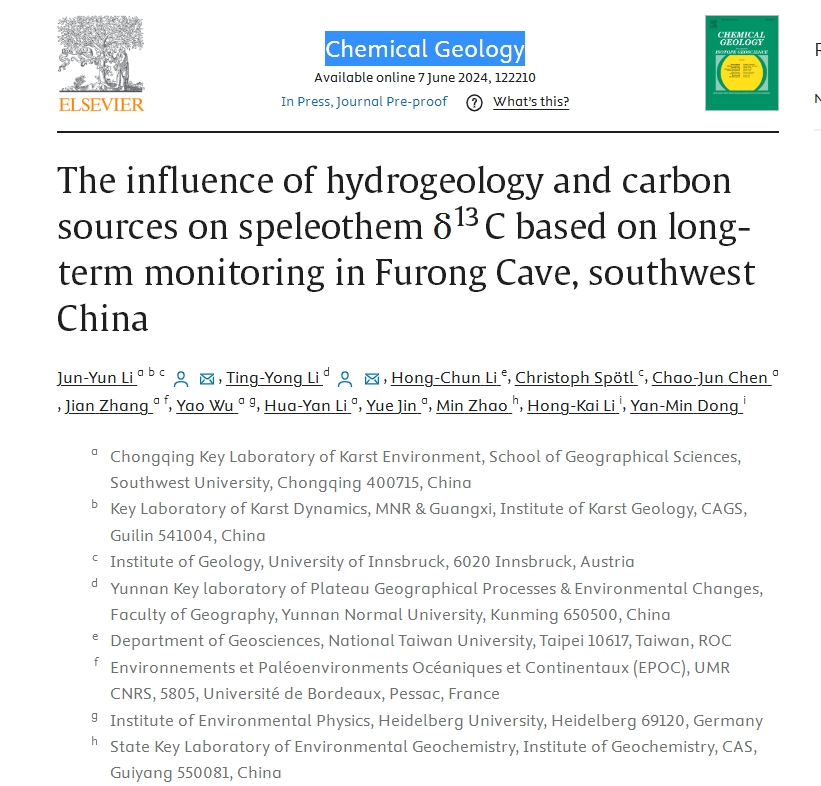博文
云师大地理学部李廷勇教授团队在top期刊《Chemical Geology》发表研究成果
||
2024年6月7日,Elsevier 旗下top期刊《Chemical Geology》在线发表了云南师范大学地理学部李廷勇教授团队的最新研究成果《The influence of hydrogeology and carbon sources on speleothem δ13C based on long-term monitoring in Furong Cave, southwest China》。云师大地理学部为第一单位,通讯作者为云南师范大学地理学部李廷勇教授。合作单位为西南大学地理科学学院、中国地质科学院岩溶地质研究所、澳大利亚因斯布鲁克大学、法国波尔多大学、中国科学院地球化学研究所、东北师范大学地理科学学院。
https://www.sciencedirect.com/science/article/abs/pii/S0009254124002900

Abstract
The stable carbon isotopic composition of speleothems is an important but incompletely understood parameter in paleoclimatological and paleoenvironmental reconstruction, recording changes in vegetation and hydrology. This study systematically assesses the influences of karst hydrology, cave environment, and carbon sources on the δ13C values of farmed calcite in Furong Cave, located in Chongqing, southwest China, according to the continuous monitoring data from six drip sites (MP1-MP5 and MP9) collected between 2009 and 2019 CE, and Δ14C values of soil organic matter, drip water, and farmed calcite (Δ14C presents the difference in the 14C/12C ratios between the sample and an absolute standard, expressed as the permill, ‰). It is found there is a linear relationship between the seasonal variability of pCO2 in cave air and δ13CCc of the farmed calcite in “Great hall” with relatively stable cave microenvironment. The growth rate and δ13CCc of the farmed calcite may not be affected by the drip rate of drip water. However, when the drip rate decreases to <1 drip/min for a long time, it may lead to a decrease in growth rate and higher δ13CCc values because of the longer CO2 degassing. By comparing the drip rate with δ13C, it is found that MP2 and MP9 with faster drip rate, heavier δ13CDIC and lower Δ14C in drip water than MP1 and MP3, which is suggested that the “old carbon” in MP9 is mainly from the host rock. MP4 and MP5, with slower drip rate and lighter δ13CDIC and δ13CCc, the Δ14C values of the farmed calcite are lower than MP9. It is inferred that the “old carbon” in drip water of MP4 and MP5 is contributed by soil CO2 released by the decomposition of organic matter for many years stored in the soil and the deep epikarst zone. The explanation is that less water supplies for MP4 and MP5 which is helpful for soil CO2 with “old carbon” from the decomposition of old organic matter entering into the fissures and dissolved in the groundwater. The fast drip rate of MP9 suggests that a large amount of water fills in the bedrock fissures, hindering the exchange between soil CO2 and CO32− in the groundwater. More “old carbon” from the bedrock dissolves in the water leading to heavier δ13CDIC of MP9. This study emphasizes that the carbon sources may be a more important control on δ13C of drip water (and speleothems) than drip rate beyond the change of cave environment.
扩展阅读:
李廷勇-地理学部https://blog.sciencenet.cn/blog-454141-1437539.html
上一篇:云师大地理学部杨昆教授团队在top期刊《Science of The Total Environment》发表研究成果
下一篇:云师大地理学部王金亮教授团队在top期刊《IEEE TGRS》发表最新研究成果
全部作者的其他最新博文
- • 云师大物电学院张伟斌、朱挺在硅酸盐top期刊《Ceramics International》发表最新研究成果
- • 云师大化工学院龚行教授课题组在《Sensors and Actuators B: Chemical》发表最新研究成果
- • 云师大地理学部胡金明教授在top期刊《 Journal of Environmental Management》发表成果
- • 云师大物电学院张伟斌、朱挺在硅酸盐top期刊《Ceramics International》发表最新研究成果
- • 云师大信息学院户战选在国际权威期刊《Neural Networks》发表研究成果
- • 云师大能环学院杨培志教授、段良飞副教授课题组在《Advanced Functional Materials》发表最新成果